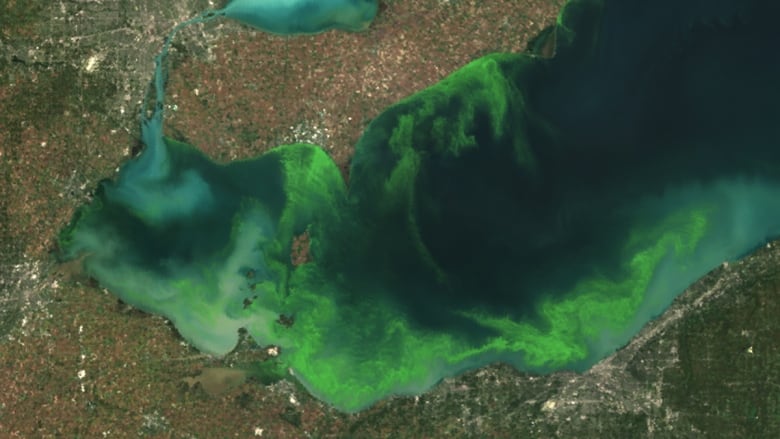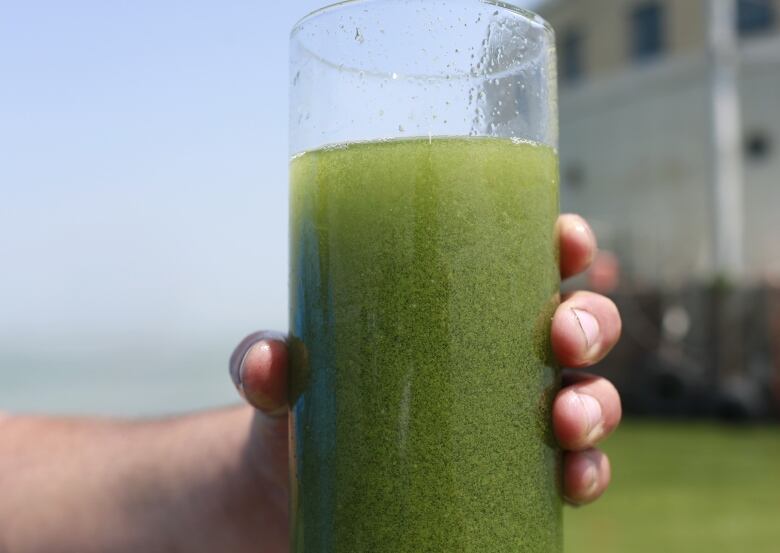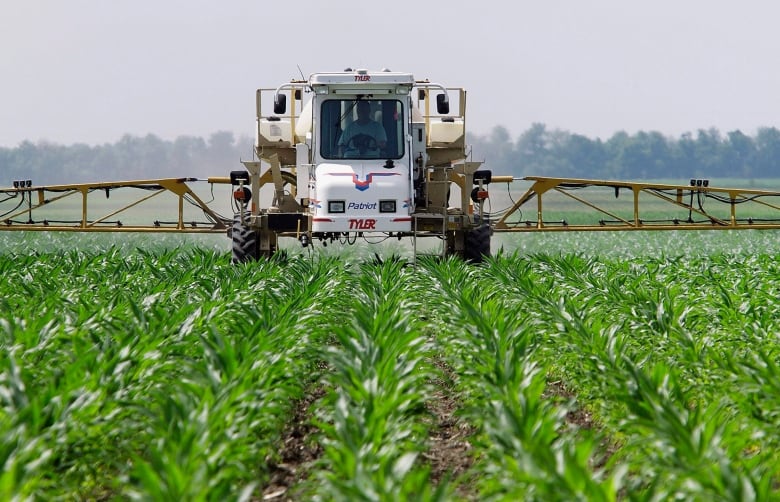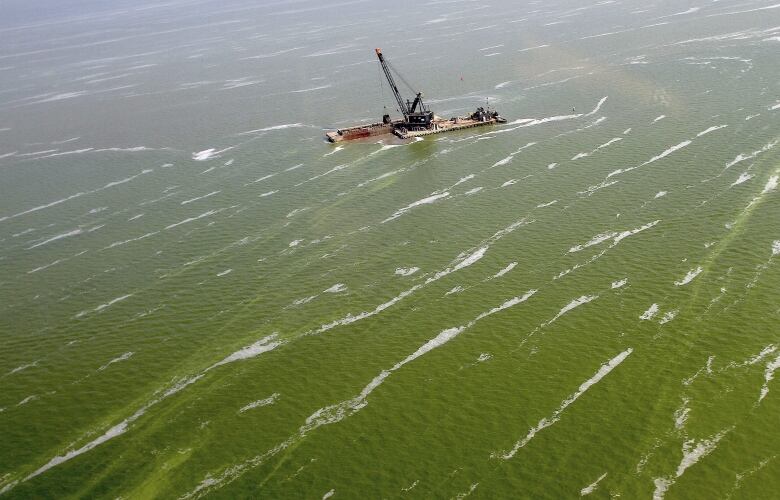Lake Erie's algae explosion blamed on farmers
Climate change an 'aggravating factor' but runoff from agriculture seen as major culprit

Toxic algae blooms in Lake Erie fouled the water that hundreds of thousands of people rely on for drinking, cooking and bathing last week, forcing hundreds of thousands of people inOhio to rely on bottled water.
The slimy green problem is back with a vengeance.Blue-green algae, or cyanobacteria, that choke up huge portions of the lake have reemerged as an annual summertime scourge after nearly disappearing for more than a decade.
And although the size of the blooms varies from year to year this year's bloom is not that big compared with the 2011 record-breaker that took over a whopping 5,000 square kilometres of the lake there is a trend toward bigger blooms.
"That seems to be what we're seeing over the past 10 years an increase in the size and severity of the blooms," said Glenn Benoy, a senior water quality specialist and science adviser with the International Joint Commission. The commission, a U.S.-Canadian collaboration to manage lakes and rivers along the countries' shared border,released a report in February about Lake Erie's algae problem that Benoy co-authored.
The algae problem was thought to have been successfully eliminated in the 1980s.
So what happened?
Scientists think the root causes of today's algae problem are not the same as what causedalgae blooms in decades past, even if the size and severity of the blooms is similar, Benoy said.

Ultimately, algae blooms are caused by excess phosphorus in the water that provides the algae with the fertilizer it needs to grow exponentially, given enough sun and warm enough water temperatures. But the source of that phosphorus can vary.
From the 1960s to the 1980s, Benoy said, the main source of phosphorus was sewage plants. The algae problem was considered so serious that communities on the shores of the lake poured billions of dollars into sewage infrastructure upgrades and implemented laws banning phosphorus in laundry detergents.
This time, the main problems arethought to be ones thatgovernments have much less direct control over. To some extent, they include the application of fertilizers to lawns and golf courses, growingexpanses ofpavement in urban areas that cause water to drain more quickly into waterways without being filtered by vegetation, and invasive zebra mussels that release extra nutrients into the water as they feed. But those aren't thought to be the biggest cause.
"We think farming is the major culprit behind the current levels of phosphorus that's in runoff and the phosphorus loads that are getting dumped into the western basin of Lake Erie," Benoy told CBC News.
Farming gets intense
The commission's report suggested that changes to farming practices were largely to blame for recent blooms.
"The main changes that are responsible have to do with intensification of farming getting more out of the land thanwe did historically," Benoy said, adding that that includes things like:
- More livestock farming and greater application of their waste to fields.
- Higher application of fertilizers in general.
- An increase in corn farming in the U.S. Midwest, partly to meet a demand for ethanol fuel.
"Corn is demanding when it comes to fertilizers," Benoy said.
When the water temperature gets to a certain level, that's when the algal blooms can really take off.- Glenn Benoy
In fact, there's so much corn being farmed in some parts of the region that it's not possible to deliver the amount of fertilizer they require in the spring, said Ivan O'Halloran, an associate professor at the University of Guelph's campus in Ridgetown, Ont., who studies soil fertility and nutrient use.
"There just isn't enough rail cars to do that."
As a result, companies sometimes offer discounts to farmers who buy and apply their fertilizer to the surface of their fields in the fall a practice that appears to significantly increase the rate at which it gets washed into local waterways.
O'Halloran said that if the practice spreads to Canada, it could make the algae problem even worse.
Ironically, some of the farming practices that help fertilizer wash into lakes began partly as a result of measures to reduce that problem back in the '60s and '70s. At that time, said Keith Reid, a soil scientist with Agriculture and Agri-Food Canada, scientists knew that erosion was a majorcause of soil and fertilizer washing into the lake, so they tried to encourage farmers to reduce erosion by not tilling or turning over the soil in their fields. That worked, but it had unintended consequences.
In the U.S., farmers who use no-till farming tend to spread fertilizer on the top of their fields, and not tilling the soil means that the fertilizer is more likely to be washed into waterways when it rains.
In Canada, farmers who use no-till farming still apply fertilizer under the ground, where there is less of a risk of it running off. Reid said that has to do with different recommendations for fertilizer application in the two jursidictions.
Both O'Halloran and Benoy said that it's not clear whether no-till farming itself is a problem, and it depends on the circumstances it reduces fertilizer runoff in some cases and may increase it in others.
O'Halloransaid, generally scientists like himself have had a hard time getting data that shows clearrelationships between particular farming practices and runoff of fertilizers into lakes, despite their efforts.
Climate change plays role
Meanwhile, climate change has become an "aggravating factor," Benoy said, as intense storms and spring runoff are washing phosphorus from farm fields into the lake more quickly than in the past. And warmer water temperatures aren't helping.
"When the water temperature gets to a certain level, that's when the algal blooms can really take off," Benoy added. "Through climate change, we would get to that water temperature more quickly during the growing season."

Sincehumans don't have much control overthe climate in the short term, when it would make a difference in this case, solutions to the algae problem need to focus on human activity.
The International Joint Commission's top recommendations are to set government targets and introduce regulations and incentives to curb application of phosphorus-based fertilizers to farm fields.
Both the U.S. and Canada have committed to update their phosphorus targets for the Great Lakes and "take action to reduce phosphorus levels that contribute to harmful algae" in the Great Lakes Water Quality Agreement, updated in 2012. Reid said Canada's federal government aims toestablish targets forphosphorus losses and concentrations in lakesby the end of 2016.
The federal government also announced in 2012 that it would spend$16 million over four yearsto address Lake Erie's algae problem through the Great Lakes Nutrient Initiative. The money is going toward bothresearch and policy development.
O'Halloran said many farmers already try to do the best they can to apply fertilizer efficiently and limit fertilizer runoff. The fertilizer industry recommends best practices to help them do that. The Ontario government has a program to test farmers' soils and recommend the right amount of fertilizer, O'Halloranadded. The federal and provincial governments also have an environmental farm plan program to help farmers deviseways to reduce their impact on the environment, Reid says.
But both Benoy and O'Halloran said the application of fertilizers is largely unregulated. In Ontario, O'Halloran said, only the application of manure and compost are regulated by the provincial government, not inorganic fertilizers.
Economic pressures
"The feeling is that the economics is the regulation to a certain extent, which is not necessarily an environmentally good thing," O'Halloran said.
Reid said that while it's true that fertilizer costs money, which should be an incentive to use it as efficiently and effectively as possible, it takes very little phosphorus to stimulate algae growth.
"The amount we're losing that has an effect on the lake is maybe oneper cent of the fertilizer that's actually applied. It's a small amount," he said. That means there isn't much of an economic incentive to prevent such small losses:"The cost of it is not that high."

Meanwhile, farmers face other economic pressures that may override the influence of the price of fertilizer.
Applying fertilizer in an underground band close to a row of seeds is the most effective way of fertilizing a field and is also thought to be the best way to prevent phosphorus runoff, O'Halloran said, but it's faster to spread the fertilizer on the surface of the soil to work in later,a practice that likely leads to more runoff into waterways.
As farms get bigger, farmers may have to work more quickly in order to plant all their fields in time. They may take shortcuts with fertilizer application even if it requires them to use more fertilizer less efficiently to mitigate the economic risk of not getting the crop in the ground in time. The planting season may be particularly short during a wet spring, increasing the time pressures on the farmer.
"I think sometimes what gets lost is the complexity of the system a farmer is dealing with," O'Halloran said.
On the other hand, he said, the kinds of practices that would cause phosphorus to wash into waterways depend a lot on the specific circumstances. For example, he said, applying fertilizer to the surface of a field in the fall may be risky in anarea where the snow falls in the winter and melts in the spring, washing the fertilizer into waterways. But it may not be so bad in warmer, drier climates without snow in the winter.
O'Halloran is concerned that regulations aimed at preventing phosphorus runoff in the highest-risk conditions may be "overly prescriptive" for the vast majority of farms.
Overall, O'Halloran thinks what is needed is more research and better information about how phosphorus is getting into Lake Erie.
But O'Halloran noted that phosphorus is a part of natural cycles in ecosystems. So while it may be a good idea to reduce theamount that gets into Lake Erie, it's neither possible nor desirable to completely eliminate it.
"You will never, in my opinion, reach zero losses."
Meanwhile, Benoy hopes that governments will take further action based on the recommendations of the International Joint Commission, to reduce the likelihood of algal blooms in the future.
He said it's not clear whether such algal blooms will threaten the drinking water of communities along Lake Erie again.
"Who knows?" he asked, but he added, "If we continue to see the amount of phosphorus getting deposited into our streams, rivers and lakes, then the likelihood is higher."












_(720p).jpg)


 OFFICIAL HD MUSIC VIDEO.jpg)
.jpg)



























































































